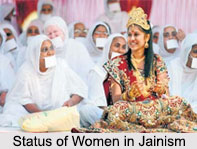 Women in Jainism are treated within the same code of ethics as that is prescribed for men. The Jain community has given a very special place to women both Sadhvi and Sravika. Women by their basic nature of love, compassion, caring, tolerance, creativity and procreative qualities have contributed immensely for the progress of self, society, Jain religion and the universe. Today, the Sadhvis (especially Terapantha) have moved globally for spreading the Jain Philosophy.
Women in Jainism are treated within the same code of ethics as that is prescribed for men. The Jain community has given a very special place to women both Sadhvi and Sravika. Women by their basic nature of love, compassion, caring, tolerance, creativity and procreative qualities have contributed immensely for the progress of self, society, Jain religion and the universe. Today, the Sadhvis (especially Terapantha) have moved globally for spreading the Jain Philosophy.
Status of Women in Jain Sects
However, the status of women in Jainism differs between the two main sects, Digambara sect and Swetambara sect. Jainism prohibits women from appearing naked. It is for this reason that the Digambaras, who consider renunciation of clothes necessary to Moksha; say that the women can"t achieve Moksha. They also believe that women must be reborn in male form before they can achieve Moksha. On the other hand the Swetambaras, who allow sadhus to wear clothes, believe that women can achieve Moksha. Some Jains consider women to be inherently inferior, but most do not. However, there are more Swetambara Sadhvis than Sadhus and women have always been influential in the Jain religion. According to the Swetambara Jains, Lord Mallinath, the 19th Jain Tirthankara; was a female. However, according to Digambara Jains Lord Mallinath was a male.
Classification of Women in Jain Agama
In the Jain Agama literature, Woman has been classified as:
1) Dravya Stree - If a person possesses a body having hairless face, breasts, vagina, uterus, etc., which are all imbibed in feminine gender, that person is called Dravya Stree.
2) Bhava Stree - If one"s body feels to unite with the body of opposite sex i.e. with a man"s body in the case of a woman it is called Bhava Stree.
Stand for Women by Lord Mahavira
As regards the status of women in the Jain community, one needs to go back to the period of Lord Mahavira. He made a crucial revolt against the existing tradition and extended his full support for the upliftment of women. He felt that they were the most neglected organ of the household where they became least powerful and most disregarded and controlled bitterly by men. Considering all these immoral practices and alimentative attitude of men towards women, Lord Mahavira stood against these pernicious social elements. He tried to free from indignation and tried to improve their status in all walks of life.
However, certain reservations had, naturally to be observed because of the slight physical incapability of women. Hence, some special rules were prescribed for nuns. Although they used to be heads of their units as Pravartini and Ganavacchedini, similar to Acharya and Upadhyaya, they were entirely responsible to the Acharyas. There were many well-known nuns of ancient period like Candana, Puspacula, Subrata. Even the patriarchal form of the society was developed and nuns were treated as slightly inferior to monks in certain respects. The Jains believe that nothing holds women as anything less than human beings who, like all souls, have the right and capability to achieve redemption.




















